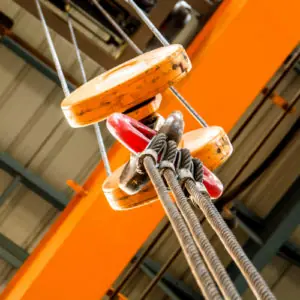 Shackles are load-bearing devices with removable pins. They can be found everywhere, from marine applications to construction sites to warehouses. In an industrial setting, you’ll often see them used with overhead cranes to lift, hold, or maneuver loads. To choose the right shackle for your overhead crane application, there are some basics you need to know, including the various types on the market, the materials and finishes available, and what type of pins should be used.
Shackles are load-bearing devices with removable pins. They can be found everywhere, from marine applications to construction sites to warehouses. In an industrial setting, you’ll often see them used with overhead cranes to lift, hold, or maneuver loads. To choose the right shackle for your overhead crane application, there are some basics you need to know, including the various types on the market, the materials and finishes available, and what type of pins should be used.
Shackle Parameters
When you look closely at a shackle, you’ll see a trademark or other means of identifying the manufacturer along with the shackle size (determined by the diameter of the shackle body or bow), and it’s SWL (Suggested Working Load). Depending on the type of shackle, you may be limited to the directionality of the load (e.g., inline-tension, perpendicular, side loads) or how many attachments can be used. And the type of pin (as well as its size) significantly impacts the types of attachments and appropriate usage. And don’t forget about the materials and finishes used. So let’s start by looking at the categories of shackles for your overhead crane application.
Types of Shackles
There are various shackle types, and in this section, we’ll focus on the most commonly used. Chain shackles are called D-shackles and have a narrow, D-shaped bow and a straight eye. Because their bow is narrower than an anchor shackle, they are rated only for in-line tension and engineered to support only one lifting device.
Anchor shackles, also called bow shackles, have more of an O shape (i.e., round eye), making it much easier to attach more than one hook or sling. In addition, this more rounded geometry allows them to support loads from multiple directions and handle wider straps. There is, however, a drawback: they have a lower working load limit than chain shackles.
As the name implies, wide-body shackles have a wider area for load distribution and a larger sling-bearing surface. This broader, more extensive area is possible because of the increased bow radius and can increase the useful life of slings. And, because they are wide-bodied, they can prevent slings from bunching and kinking. Wide-body shackles also work well with wire rope, synthetic round, and high-capacity synthetic web slings.
Twisted shackles are forged to a 90-degree twist that allows you to attach a hook or sling from the side (in the same direction as the pin is facing) instead of the front. In addition, their design supports perpendicular attachment points without resulting in torque.
Snap shackles have a spring-activated mechanism for the pin that makes it easy to use when only one hand is available, speed is of the essence, or the item is hooked/unhooked often. However, snap shackles cannot securely handle heavy-duty loads.
Materials and Finishes for Shackles
There are several options for the shackle/pin material and its finishes.
Carbon steel shackles are available as round, screw, and bolt-type pins. They are going to be more ductile and allow steel and stainless steel. Alloy steel shackles will be stronger than carbon steel shackles and offer the same working load limit as a carbon steel shackle while being smaller. As with their carbon steel counterparts, they are also available in round, screw, and bolt-type pins. Stainless steel shackles (e.g., 314 or 316 stainless) provide excellent strength and significantly greater corrosion resistance than carbon and alloy steel (even when galvanized). However, at the same time, they will cost more.
Steel shackles also come in several different finishes, including …
- Plain
- Painted
- Hot-dip Galvanized
- Hot-dip Galvanized and Painted
- Powder-coated
Galvanized coatings are reserved for non-stainless steel (e.g., carbon and alloy steels) shackles and refer to a zinc oxide coating. Both stainless steel and galvanized steel are corrosion-resistant. However, galvanized shackles really work best where moisture isn’t a significant problem. Stainless steel, however, results in a strong, highly corrosion-resistant shackle that can handle high chloride environments.
Pin Type
Let’s discuss the different pin types. Round pins are removable cotter pins and are ideal for loads that can lead to torque or twisting. Unfortunately, round pin shackles don’t do so well with axial loads, making them inappropriate for overhead lifting.
Bolt pins, which combine a bolt and nut with a cotter pin, work well for securing long-term or permanent loads and can handle loads that try to slide on the pin. Bolt-type shackles are very secure, even when torque or rotation is present, because they cannot unscrew while in service. They work exceptionally well for (a) semi-permanent or long-term use and (b) where the load may slide and cause the shackle pin to rotate.
Screw pins are very easy to connect/disconnect and consist of a threaded pin secured by tightening it — but they can come unscrewed while in service. While screw-type shackles are easy to use for applications where slings and other hardware are changed frequently, they don’t work well for long-term or permanent installations. On the other hand, they can handle multi-leg sling assemblies.
Captive pins cannot be removed from the shackle’s bow, making them a good choice for environments where a lost pin might be practically impossible to find, such as marine applications.
Conclusion
Selecting the right shackle for your overhead crane application or facility can be challenging, but a foundational knowledge of shackles is a great place to start. The right combination of shackle type, size, pin, and material/finish can help you develop the perfect loading/lifting/holding solution for your overhead cranes.
If you feel a bit overwhelmed by the shackle options available, or just have a few questions, feel free to contact the experts at Hi-Speed Industrial Service. Our knowledgeable team will be able to help you work your way through the many options until you have a solution to fit your application and your budget.

